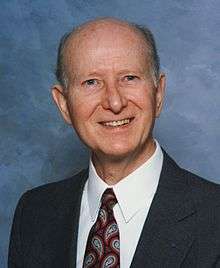Dade Moeller
Dade Moeller (27 February 1927 – 26 September 2011) was an internationally known expert in radiation safety and environmental protection.
Dade William Moeller | |
|---|---|
 | |
| Born | February 27, 1927 Grant, Florida, US |
| Died | September 26, 2011 (aged 84) |
| Resting place | New Bern, North Carolina |
| Nationality | American |
| Other names | Dade Moeller |
| Alma mater |
|
| Spouse(s) | Betty Jean Radford |
| Children | 5 |
| Awards |
|
| Scientific career | |
| Fields |
|
| Institutions |
|
| Thesis | Radionuclides in Reactor Cooling Water-Identification, Source and Control[1] (1957) |
Life
Dade William Moeller, Ph.D., CHP, P.E. was born in 1927 in Grant, Florida a fishing community located on the intracoastal waterway near the Atlantic Ocean. His father was Robert A. Moeller and his mother was Victoria Moeller and he had 3 brothers, Charles E. Moeller, Robert L. Moeller, and John A. Moeller. In 1949 he married Betty Jean Radford 'Jeanie' of Decatur, Georgia. Moeller died at home from complications due to malignant lymphoma on 26 September 2011.[2][3]
Military service and education
He passed the V-12 Navy College Training Program, and joined the U.S. Navy in 1944. Moeller attended Georgia Tech and graduated magna cum laude with a Bachelor of Science degree in Civil Engineering in 1947 and a Master of Science degree in Environmental Engineering in 1948. After graduating, Dade became a commissioned officer in the U.S. Public Health Service, with assignments that included Oak Ridge National Laboratory, Los Alamos National Laboratory, and the Headquarters office in Washington, D.C.[2][4]
In 1957 with sponsorship from the U.S. Public Health Service, Moeller earned the Doctor of Philosophy degree in Nuclear Engineering from North Carolina State University.[1] He taught radiation protection courses at the U.S. Public Health Service's Radiological Health Training Center in Cincinnati, Ohio. In 1959 Moeller joined the Health Physics Society and became a Certified Health Physicist and a Certified Environmental Engineer. In 1961 Moeller became the Officer in Charge at the Northeastern Radiological Health Laboratory in Winchester, Massachusetts and studied radioactive fallout from atomic weapons testing and monitored children's thyroids for the uptake of radioactive iodine. In 1966 Moeller retired from the U.S. Public Health Service.[2][4]
Harvard School of Public Health
Moeller held tenure for 26 years and served as:
- Professor of Engineering in Environmental Health
- Associate Director of the Kresge Center for Environmental Health
- Associate Director of the Harvard-National Institute of Environmental Health Sciences Center for Environmental Health
- Chairman of the Department of Environmental Health Sciences
- Associate Dean for Continuing Education
- Taught in the Center for Continuing Professional Education
Memberships
- American Association for the Advancement of Science
- American Industrial Hygiene Association
- American Nuclear Society
- American Public Health Association
- Health Physics Society
Awards and honors
- Health Physics Society, Fellow, 1968
- National Academy of Engineering, Fellow, 1978
- American Public Health Association, Fellow, 1988
- American Nuclear Society, Fellow, 1988
- U.S. Nuclear Regulatory Commission, Meritorious Achievement Award, 1988
- National Council on Radiological Protection and Measurements, Distinguished Emeritus Member, 1997
- Georgia Institute of Technology, Engineering Hall of Fame, 1999
- NC State University, Distinguished Engineering Alumni Award, 2001[5]
- Health Physics Society, Robley D. Evans Commemorative Medal, 2003
- William McAdams Outstanding Service Award, American Academy of Health Physics, 2005
- Professor Emeritus Award of Merit, Harvard University School of Public Health, 2006
Select publications
Thesis
- Radionuclides in Reactor Cooling Water-Identification, Source and Control. (1957).[1]
References
- Moeller, Dade William. (1957). Radionuclides in Reactor Cooling Water-Identification, Source and Control. Thesis (Ph.D.). Nuclear Engineering. North Carolina State University. Raleigh, N.C. xi, 161 p. tables, illus. 29 cm. http://catalog.lib.ncsu.edu/record/NCSU506917
- Maher, Edward F. (2011). In Memoriam: Dade W. Moeller, CHP. 1927-2011. Health Physics Society. http://hps.org/aboutthesociety/people/inmemoriam/DadeMoeller.html.
- Editor. (2 October 2011). Dade William Moeller. Sun Journal. New Bern, North Carolina.
- Maher, Edward F. (November 2011). Dade W. Moeller, CHP. 1927-2011. Health Physics News. XXXIX(11): 8-9.
- "Moeller Profile". Archived from the original on 2012-05-16. Retrieved 2015-08-10.
- Maher, Edward F., Moeller, Dade W., and Rudnick, Stephen N. (24 June 1986). U.S. Patent No. 4,596,585. Washington, DC: U.S. Patent and Trademark Office.
- Moeller, Dade W., and Rudnick, Stephen N. (31 August 1993). U.S. Patent No. 5,241,449. Washington, DC: U.S. Patent and Trademark Office.